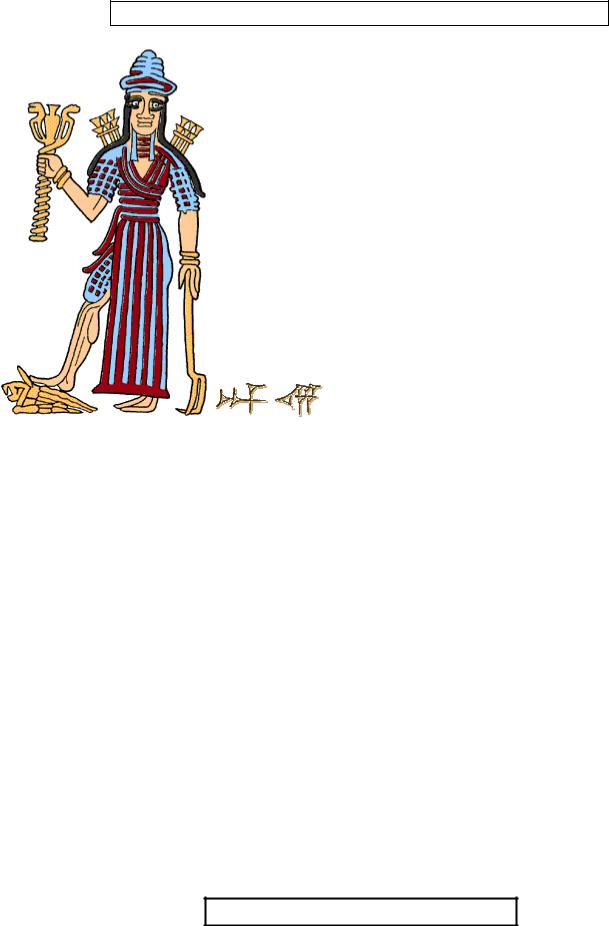
silo.tips_adad-is-the-god-of-storms-he-is-usually-shown-carrying-a-lighting-fork
.pdf
Gods, Goddesses, Demons, and Monsters of Mesopotamia
Ellilis one of the most important gods of Mesopotamia. Ellil is so powerful that
the other gods can't even look at him. He is therefore only shown as a horned cap.
Ellil's main city is Nippur. Kings from all over Mesopotamia sent offerings to him there. Ellil is the father of many other important Mesopotamian gods and goddesses.
Ellil guards the 'tablets of destiny'. These are cuneiform tablets on which he writes the fate of everything on earth.
RPC Museum of Mesopotamia

Gods, Goddesses, Demons, and Monsters of Mesopotamia
Ereshkigalis the Sumerian goddess of the
underworld.
Ereshkigal was a cunning and clever goddess who ruled over the underworld.
When Inanna (the Sumerian name for the goddess Ishtar) ventured into the underworld, Ereshkigal forced her to take off a piece of clothing at each of the seven gates before she reached her. Ereshkigal knew that if Inanna arrived naked, she would be stripped of her special powers.
RPC Museum of Mesopotamia

Gods, Goddesses, Demons, and Monsters of Mesopotamia
Gulawas a goddess of healing, a patroness of doctors and a constellation.
She often appears as a woman with stars and her dog.
People dedicated small statues of dogs to Gula because they believed it would help them avoid, or recover from, illness.
RPC Museum of Mesopotamia

Gods, Goddesses, Demons, and Monsters of Mesopotamia
Human-headed
bullsare protective creatures. They are found decorating objects dating mainly from
around 3000-1800 B.C. and later are replaced by the lamassu guardian figures.
RPC Museum of Mesopotamia

Gods, Goddesses, Demons, and Monsters of Mesopotamia
Ishtaris the morning and evening star (the planet we call Venus), and the
goddess of love and war. She is shown as a woman standing on a lion, generally holding several weapons.
Ishtar was sometimes thought to be the daughter of the moon god Sin. Since the lunar month usually has 30 days, Sin's sacred number is 30. As Ishtar was Sin's daughter, her sacred number is 15.
RPC Museum of Mesopotamia

Gods, Goddesses, Demons, and Monsters of Mesopotamia
Lamais a goddess people prayed to for their own personal protection. She
appears as a woman in a long, tiered skirt.
Lama is often shown on cylinder seals leading people into the presence of important gods and goddesses.
RPC Museum of Mesopotamia

Gods, Goddesses, Demons, and Monsters of Mesopotamia
Lamashtuis an evil demon who preys upon unborn and
newborn children. She had a hairy body, a lioness' head with donkey's teeth and ears, long fingers and fingernails and the feet of a bird with sharp talons.
She is often shown standing or kneeling on a donkey, nursing a pig and a dog, and holding snakes. Pregnant women often wore amulets of Pazuzu, the demon who fought against Lamashtu.
RPC Museum of Mesopotamia

Gods, Goddesses, Demons, and Monsters of Mesopotamia
A lamassuwas a human-headed winged bull or lion.
Huge sculptures of lamassus guarded Assyrian palace doorways and city gates. They were there to frighten away the forces of chaos.
RPC Museum of Mesopotamia

Gods, Goddesses, Demons, and Monsters of Mesopotamia
Mardukis the city god of Babylon.
When Babylon became the capital of Babylonia (from about 1500 B.C.), Marduk became more important. Marduk is sometimes called 'Bel' which means 'lord'.
Marduk's symbols are a spade and the Mushhushshu snake-dragon.
In Babylonian mythology, Marduk is called upon to fight an army of demons led by the goddess
Tiamat.
He goes into battle when the other gods agree to elect him as their leader. He hunts down Tiamat, kills her and is crowned as the supreme god.
The citizens of Babylon celebrated a New Year festival, during which the king would kneel before a statue of Marduk and vow that he was a good ruler.
RPC Museum of Mesopotamia

Gods, Goddesses, Demons, and Monsters of Mesopotamia
The Mushhushshuprotects many
of the supreme gods. Its name means 'furious snake'.
Gods like Marduk, Ashur, Ellil and Nabu all rode on a mushhushshu dragon.
RPC Museum of Mesopotamia
